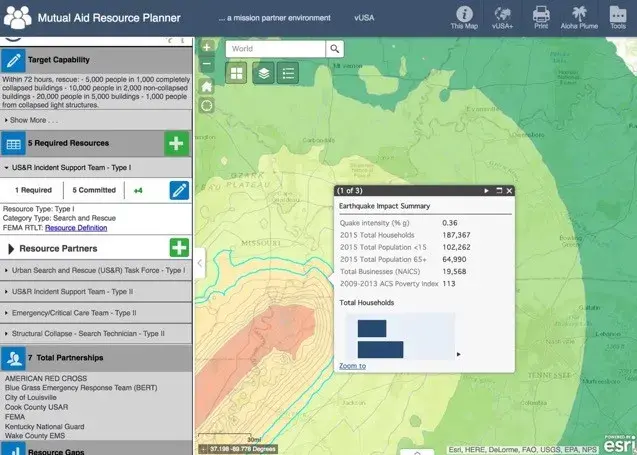The Department of Homeland Security’s (DHS) Science and Technology Directorate (S&T) First Responders Group (FRG) is focused on enhancing resiliency and emergency preparedness in local communities. FRG understands that when local, state and federal agencies plan ahead or pool resources in the wake of a disaster, the outcomes of managing relief efforts are improved.
 Imagine if a small town has just suffered an unprecedented natural disaster of a magnitude requiring more resources than emergency responders have on hand. Reaching out to nearby towns for mutual aid to support resource needs is essential for them to quickly respond and recover from the tragic incident. This scenario is exceedingly common; mutual aid requests like these are carried out on a routine basis by emergency management professionals at all levels of government.
Imagine if a small town has just suffered an unprecedented natural disaster of a magnitude requiring more resources than emergency responders have on hand. Reaching out to nearby towns for mutual aid to support resource needs is essential for them to quickly respond and recover from the tragic incident. This scenario is exceedingly common; mutual aid requests like these are carried out on a routine basis by emergency management professionals at all levels of government.
In most cases, having plans for such assistance in place before a disaster strikes can greatly mitigate potential risk during the aftermath, especially when the plans recognize how each mutual aid partner can contribute. FRG has facilitated research and development efforts to advance mutual aid. This has included work with the Kentucky Emergency Management Agency and the National Emergency Management Association (NEMA) on co-developing a capability for authoring and sharing information on Mission Ready Packages (MRPs). MRPS are specific response and recovery resource capabilities that are organized and packaged to allow for quicker discovery and deployment of resources during an emergency. MRPs were tested during the Central U.S. Earthquake Consortium’s CAPSTONE 2014 exercise and later adopted by NEMA.
Building on what was learned from this previous mutual aid work, FRG developed a prototype application designed to help jurisdictions develop and resource their own capability-based plans. The application is the Mutual Aid Resource Planner (MARP). The National Information Sharing Consortium (NISC) currently hosts the MARP tool, which is based on ArcGIS online, a cloud-based platform that enables rapid deployment of the application to users and helps to streamline information sharing between partners. As an ESRI ArcGIS Online configurable template, MARP is intended to be managed by a community or emergency management agency.
Requirements for the MARP application were initially developed during CAPSTONE14. This application extends the resource planning concept outlined by the Federal Emergency Management Agency’s Threat and Hazard Identification and Risk Assessment (THIRA) process. The THIRA process enables communities to determine their capabilities and establish the resources required to achieve their individual targets.
MARP allows planners to add existing geospatial hazards and risk assessments to develop more accurate resource plans. By pre-identifying the partners who can provide mutual aid to fill resource gaps, the MARP platform could help resource planners create a more effective and resilient system. This type of deployment offers the opportunity for joint collaboration on assigning responsibilities to different agencies and reviewing situational awareness between neighboring jurisdictions.
MARP has been tested through a virtual pilot series and multiple experiments. During the prototype phase an orientation session was conducted with stakeholders from multiple levels of government agencies to test the application. Communities from both Michigan and Ontario used MARP to develop cross-border mutual aid plans during CAUSE IV experiment in April 2016.
 This past January, the MARP’s capabilities were tested again as part of the first experiment under the Flood Apex program. The experiment was held in a city that has dealt with major flooding in the past: New Orleans. The goal of the MARP is to provide the necessary information to build a better plan, thereby strengthening a municipality’s community preparedness and resilience.
This past January, the MARP’s capabilities were tested again as part of the first experiment under the Flood Apex program. The experiment was held in a city that has dealt with major flooding in the past: New Orleans. The goal of the MARP is to provide the necessary information to build a better plan, thereby strengthening a municipality’s community preparedness and resilience.
The core features of the MARP are the innovative design approaches that make it easier to collaborate with data and to develop “living plans” that reflect reliance between communities shared resources following catastrophic events.
MARP picks up where the THIRA processes end by enabling planners to collaboratively develop capability-based resource plans and identify partners to support resource shortfalls. Other important characteristics of the MARP include:
- Aligning with local, state and federal goals related to THIRA and resource planning;
- Enabling users to share plans and resource needs with partner jurisdictions;
- Helping unite the efforts of analysts and modelers with planning and operations staff; and
- Providing a simplified planning template for an organization’s information sharing platform.
